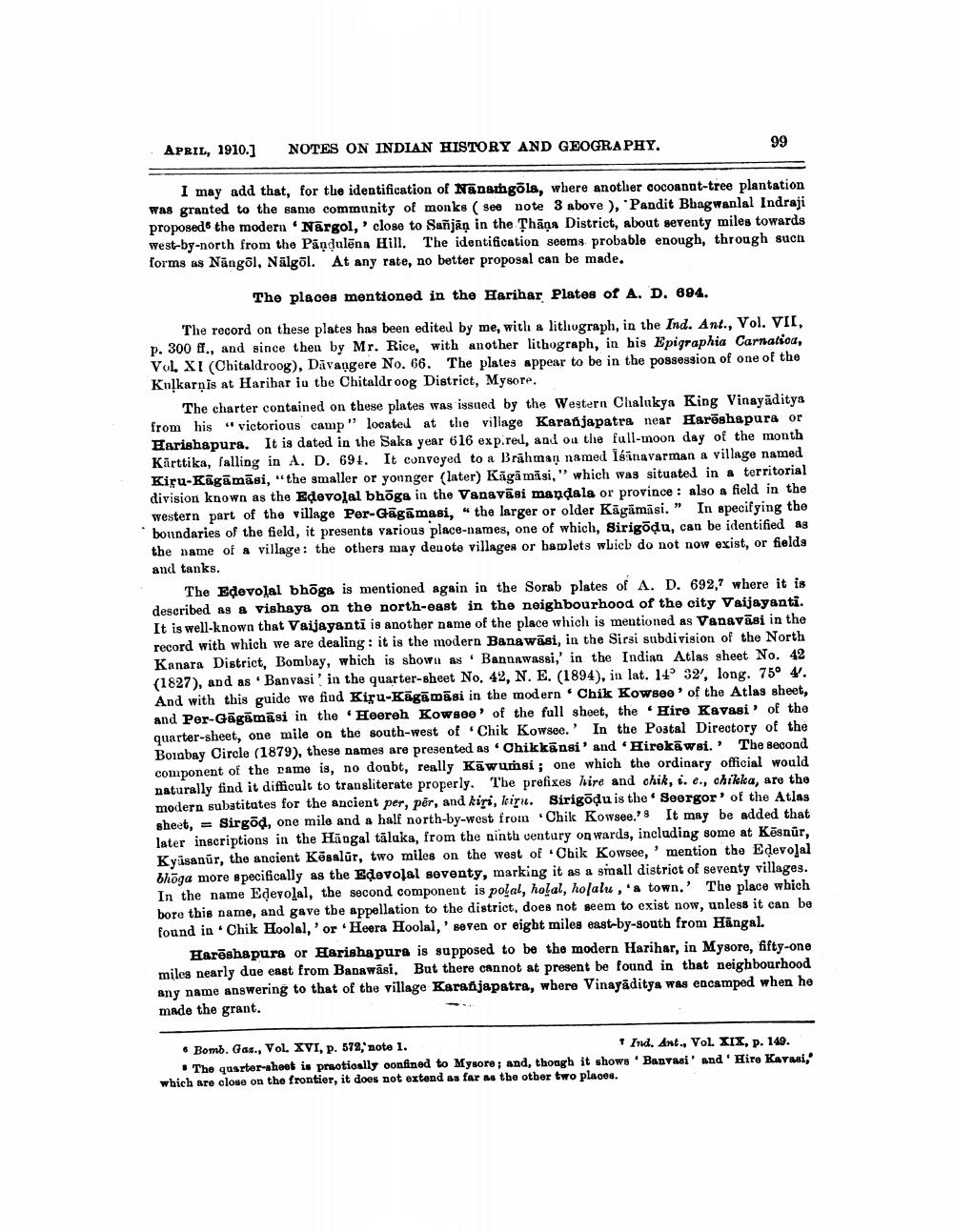________________
APRIL, 1910.]
NOTES ON INDIAN HISTORY AND GEOGRAPHY.
99
I may add that, for the identification of Nanamgols, where another cocoanat-tree plantation was granted to the same community of monks ( see note 3 above ), Pandit Bhagwanlal Indraji proposed the modern Nārgol, close to Sañjāņ in the Thāņa District, about seventy miles towards West-by-north from the Pandulēna Hill. The identification seems probable enough, through such forms as Nãngöl, Nālgol. At any rate, no better proposal can be made.
The places mentioned in the Harihar Plates of A. D. 694.
The record on these plates has been edited by me, with a lithograph, in the Ind. Ant., Vol. VII, p. 300 ff., and since then by Mr. Rice, with another lithograph, in his Epigraphia Carnatioa, VOL XI (Chitaldroog), Dāvangere No. 66. The plates appear to be in the possession of one of the Kuļkarnis at Harihar in the Chitaldr oog District, Mysore.
The charter contained on these plates was issued by the Western Chalukya King Vinayāditya from his " victorious camp" located at the village Karanjapatra near Harēshapura or Harishapura. It is dated in the Saka year 616 exp.red, and ou the full-moon day of the month Kārttika, falling in A. D. 691. It conveyed to a Brāhmaṇ named Isangvarman a village named Kiru-Kāgāmāsi, "the smaller or younger (later) Kāgā māsi," which was situated in a territorial division known as the Edevolal bhöga in the Vanavāsi mandala or province : also a field in the western part of the village Per-Gāgāmasi, “ the larger or older Kāgāmisi.” In specifying the boundaries of the field, it presents various place-names, one of which, Sirigāļu, can be identified as the name of a village: the others may deuote villages or hamlets whicb do not now exist, or fields and tanks.
The Edevolal bhāga is mentioned again in the Sorab plates of A. D. 692, where it is described as & vishaya on the north-east in the neighbourhood of the city Vaijayanti. It is well-known that Vaijayanti is another name of the place which is mentioned as Vanavāsi in the record with which we are dealing : it is the modern Bangwāsi, in the Sirsi subdivision of the North Kanara District, Bombay, which is shown as · Bannawassi,' in the Indian Atlas sheet No. 42 (1827), and as · Banvasi' in the quarter-sheet No. 42, N. E. (1894), in lat. 14° 32', long. 75° 4. And with this guide we find Kiru-Kāgāmāsi in the modern Chik Kowsee of the Atlas sheet, and Per-Gāgāmāsi in the 'Heereh Kowsee' of the full sheet, the Hire Kavasi' of the quarter-sheet, one mile on the south-west of Chik Kowsee.' In the Postal Directory of the Boinbay Circle (1879), these names are presented as Chikkānsi' and 'Hirokāwsi.' The second component of the came is, no doubt, really Kāwumsi; one which the ordinary official would naturally find it difficult to transliterate properly. The prefixes hire and chik, s. e., chikka, are the modern substitutes for the ancient per, pēr, and kiri, leiru. Sirigodu is the Seergor' of the Atlas sheet, = Sirgöd, one mile and a half north-by-west from Chik Kowsee. It may be added that later inscriptions in the Hāngal tāluka, from the ninth century on wards, including some at Kēsnür, Kyūsanur, the ancient Kösalur, two miles on the west of Chik Kowsee,' mention the Edevolal bhöga more specifically as the Edovolal soventy, marking it as a small district of seventy villages. In the name Edevolal, the second component is polal, holal, hofalu, 'a town.' The place which bore this name, and gave the appellation to the district, does not seem to exist now, unless it can be found in .Chik Hoolal,' or Heera Hoolal,' geven or eight miles east-by-south from Hãngal.
Harēshapura or Harishapura is supposed to be the modern Harihar, in Mysore, fifty-one miles nearly due east from Banawāsi, But there cannot at present be found in that neighbourhood any name answering to that of the village Karañjapatra, where Vinayāditya was encamped when he made the grant.
• Bomb. Gas., VOL. XVI, p. 572, note 1.
+ Ind. Ant., Vol. XIX, p. 149. • The quarter-sheet is practioslly confined to Mysore ; and, though it shows 'Banvasi' and 'Hire Kavasi, which are close on the frontier, it does not extend as far as the other two places.




